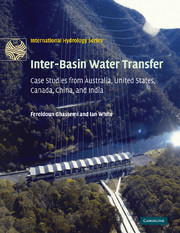Book contents
- Frontmatter
- Contents
- Foreword
- Overview and Scope
- Acknowledgements
- List of Abbreviations
- Part I The Challenges
- Part II Inter-basin Water Transfer in Australia
- Part III Inter-basin Water Transfer in Other Selected Countries
- 11 Inter-basin water transfer in the United States of America
- 12 Inter-basin water transfer in Canada
- 13 Inter-basin water transfer in China
- 14 India: The National River-Linking Project
- 15 Inter-basin water transfer, successes, failures and the future
- Part IV Appendices
- Glossary
- Index
- References
12 - Inter-basin water transfer in Canada
Published online by Cambridge University Press: 05 November 2009
- Frontmatter
- Contents
- Foreword
- Overview and Scope
- Acknowledgements
- List of Abbreviations
- Part I The Challenges
- Part II Inter-basin Water Transfer in Australia
- Part III Inter-basin Water Transfer in Other Selected Countries
- 11 Inter-basin water transfer in the United States of America
- 12 Inter-basin water transfer in Canada
- 13 Inter-basin water transfer in China
- 14 India: The National River-Linking Project
- 15 Inter-basin water transfer, successes, failures and the future
- Part IV Appendices
- Glossary
- Index
- References
Summary
OVERVIEW OF GEOGRAPHY, POPULATION, LAND AND WATER
GEOGRAPHY
Canada covers an area of about 9 984 670 km2, consisting of 9 093 507 km2 of land and 891 163 km2 of freshwater lakes. It is the second largest country in the world after Russia and covers more than half of the North American continent. It extends from the Atlantic Ocean to the Pacific Ocean and from the northern boundary of the United States to the Polar Regions. Canada is a federation of 10 provinces and three territories. Seven physiographic regions are distinguishable in Canada (Figure 12.1). These regions are (Bone, 2002):
Canadian Shield is the largest region and covers about half the total area of Canada. It forms an incomplete ring around Hudson Bay and consists of Precambrian volcanic rocks of 3500 million to 600 million years old. Originally, it was the site of high mountain ranges, which have since been eroded over geological time. It consists mainly of a rugged, rolling upland.
Cordillera is a complex region of mountains, plateaus, and valleys. It is a young geological structure, which was formed 40 to 80 million years ago. The Rocky Mountains are the best-known mountain ranges of Cordillera, which have elevations between 3000 m to 4000 m.
Interior Plains is a northward extension of the Great Plains of the United States. The oldest sedimentary rocks of the region were formed about 500 million years ago. Since then, other sedimentary layers have been deposited on top of them.
[…]
- Type
- Chapter
- Information
- Inter-Basin Water TransferCase Studies from Australia, United States, Canada, China and India, pp. 261 - 294Publisher: Cambridge University PressPrint publication year: 2007



